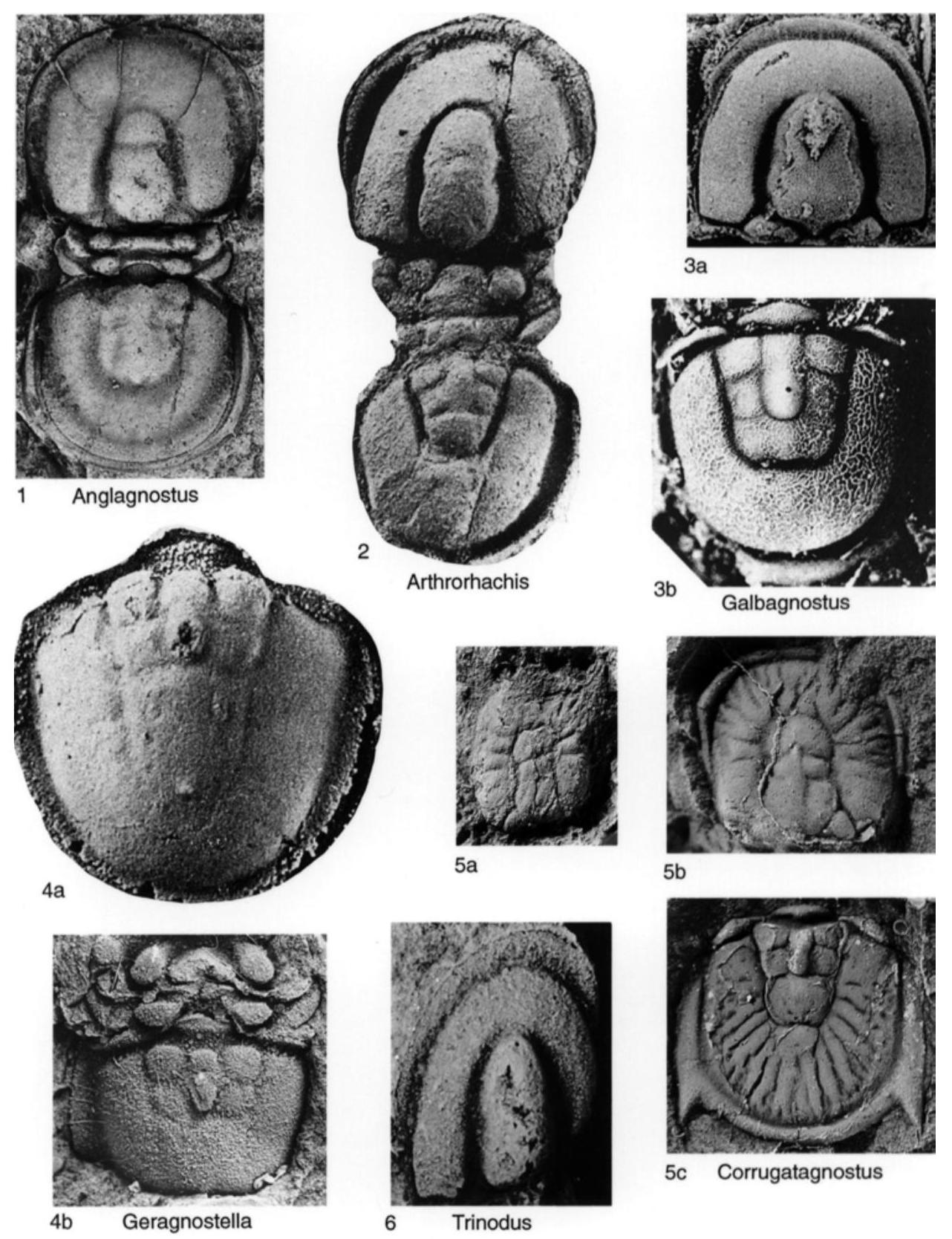Welcome to the Treatise on Invertebrate Paleontology!
Please enter a genera name to retrieve more information.

Corrugatagnostus
Classification
Phylum:
Arthropoda
Class:
Trilobita
Order:
Agnostida
Superfamily:
Agnostoidea
Family:
Metagnostidae
Formal Genus Name and Reference:
Corrugatagnostus KOBAYASHI, 1939a, p. 173
Type Species:
Agnostus perrugatus Barrande, 1872, p. 143, OD, = A. morea Salter, 1864b, p. 7, holotype by monotypy (SALTER, 1864b, pl. 1, fig. 13), 8699, BGS, London
Images
(Click to enlarge in a new window)
Fig. 236,5a–c. *C. morea (SALTER), Lower Ordovician (Llanvirn); a, England (Shelve Inlier, Shropshire), holotype, cephalon, BGS 8699, ×5 (new); b,c, England (Old Church Stoke, Shropshire), b, cephalon, BGS 92922, ×5; c, pygidium, BGS 92923a, ×5 (new).
Synonyms
Segmentagnostus, Granulatagnostus
Geographic Distribution
Czechoslovakia, Llandeilo–lower Caradoc; England, Arenig–lower Llanvirn; Scotland, upper Caradoc–Ashgill; Ireland, Ashgill; Belgium, Llandeilo; France, ?lower Arenig; ?Argentina, lower Tremadoc; Russia (Altay Mountains), ?Upper Cambrian; Kazakhstan, middle–upper Caradoc; Uzbekistan, Ashgill; China (Zhejiang, Jiangsu), ?Tremadoc, upper Caradoc–Ashgill; USA (Texas), Lower Ordovician; Poland, Ashgill.
Age Range
Beginning Stage in Treatise Usage:
Upper Cambrian
Beginning International Stage:
Guzhangian
Fraction Up In Beginning Stage:
50
Beginning Date:
498.75
Ending Stage in Treatise Usage:
Upper Ordovician
Ending International Stage:
Hirnantian
Fraction Up In Ending Stage:
100
Ending Date:
443.07
Description
Glabella with semiovate to semicircular anterior lobe, F3 chevron shaped, posterior lobe with F2 variably developed, chevron shaped, glabellar node from immediately behind F3 to well onto anterior glabellar lobe. Pygidial axis very short, tapering rearward or with slight constriction across M2, posterior lobe transverse, subrectangular to trapeziform, usually with weak terminal node.
References
Museum or Author Information
Classification
Phylum:
Arthropoda
Class:
Trilobita
Order:
Agnostida
Superfamily:
Agnostoidea
Family:
Metagnostidae
Formal Genus Name and Reference:
Corrugatagnostus KOBAYASHI, 1939a, p. 173
Type Species:
Agnostus perrugatus Barrande, 1872, p. 143, OD, = A. morea Salter, 1864b, p. 7, holotype by monotypy (SALTER, 1864b, pl. 1, fig. 13), 8699, BGS, London
Images
(Click to enlarge in a new window)
Fig. 236,5a–c. *C. morea (SALTER), Lower Ordovician (Llanvirn); a, England (Shelve Inlier, Shropshire), holotype, cephalon, BGS 8699, ×5 (new); b,c, England (Old Church Stoke, Shropshire), b, cephalon, BGS 92922, ×5; c, pygidium, BGS 92923a, ×5 (new).
Synonyms
Segmentagnostus, Granulatagnostus
Geographic Distribution
Czechoslovakia, Llandeilo–lower Caradoc; England, Arenig–lower Llanvirn; Scotland, upper Caradoc–Ashgill; Ireland, Ashgill; Belgium, Llandeilo; France, ?lower Arenig; ?Argentina, lower Tremadoc; Russia (Altay Mountains), ?Upper Cambrian; Kazakhstan, middle–upper Caradoc; Uzbekistan, Ashgill; China (Zhejiang, Jiangsu), ?Tremadoc, upper Caradoc–Ashgill; USA (Texas), Lower Ordovician; Poland, Ashgill.
Age Range
Beginning Stage in Treatise Usage:
Upper Cambrian
Beginning International Stage:
Guzhangian
Fraction Up In Beginning Stage:
50
Beginning Date:
498.75
Ending Stage in Treatise Usage:
Upper Ordovician
Ending International Stage:
Hirnantian
Fraction Up In Ending Stage:
100
Ending Date:
443.07
Description
Glabella with semiovate to semicircular anterior lobe, F3 chevron shaped, posterior lobe with F2 variably developed, chevron shaped, glabellar node from immediately behind F3 to well onto anterior glabellar lobe. Pygidial axis very short, tapering rearward or with slight constriction across M2, posterior lobe transverse, subrectangular to trapeziform, usually with weak terminal node.
